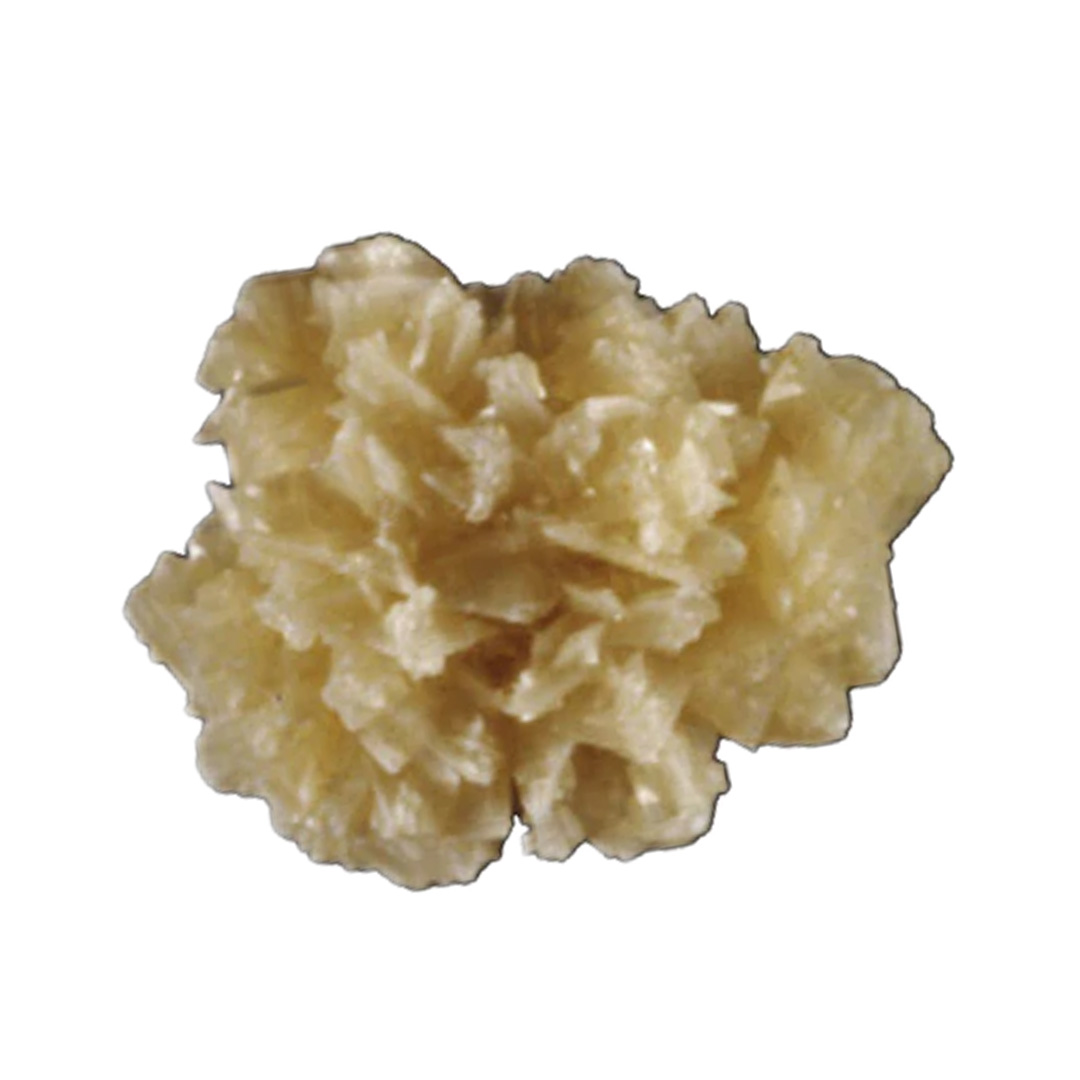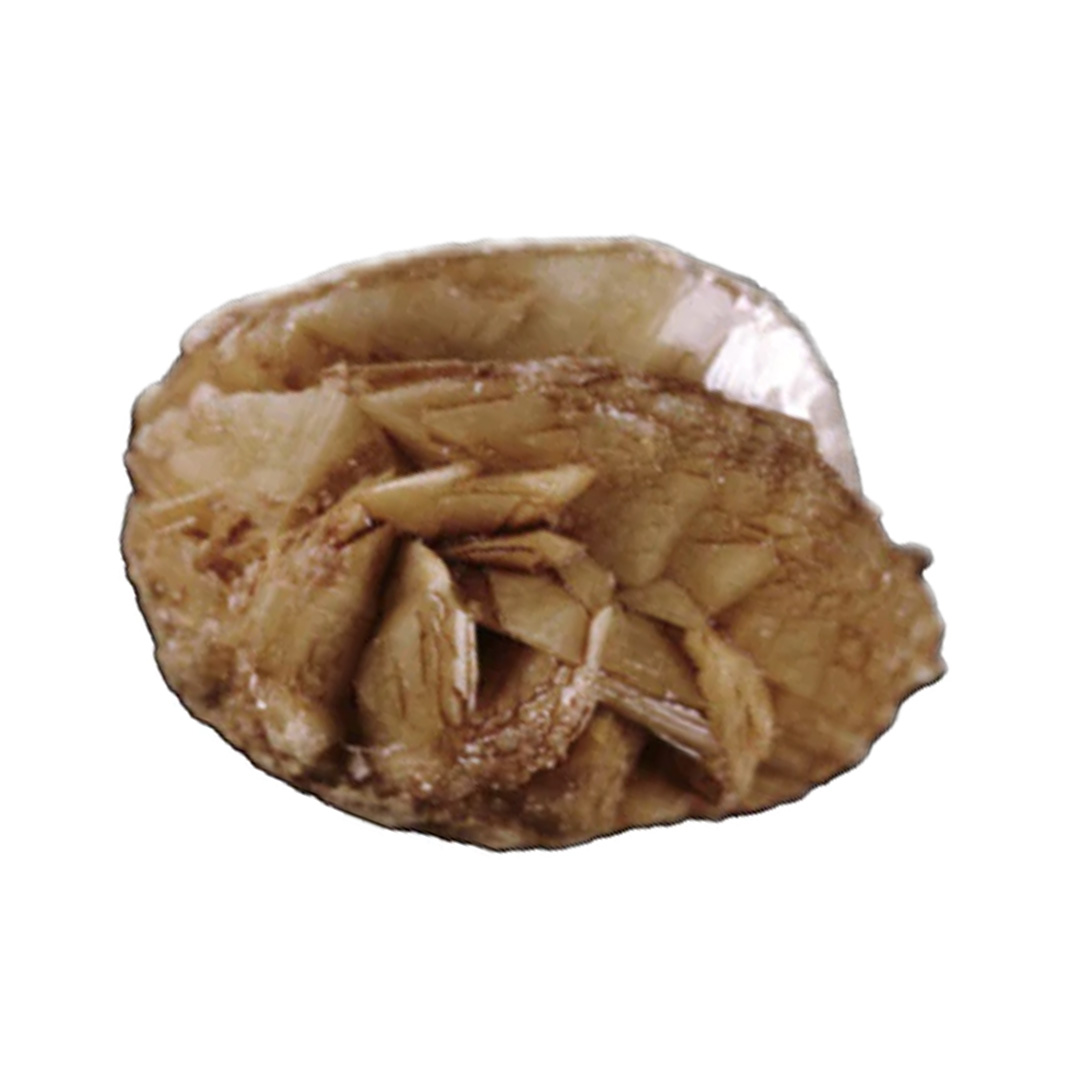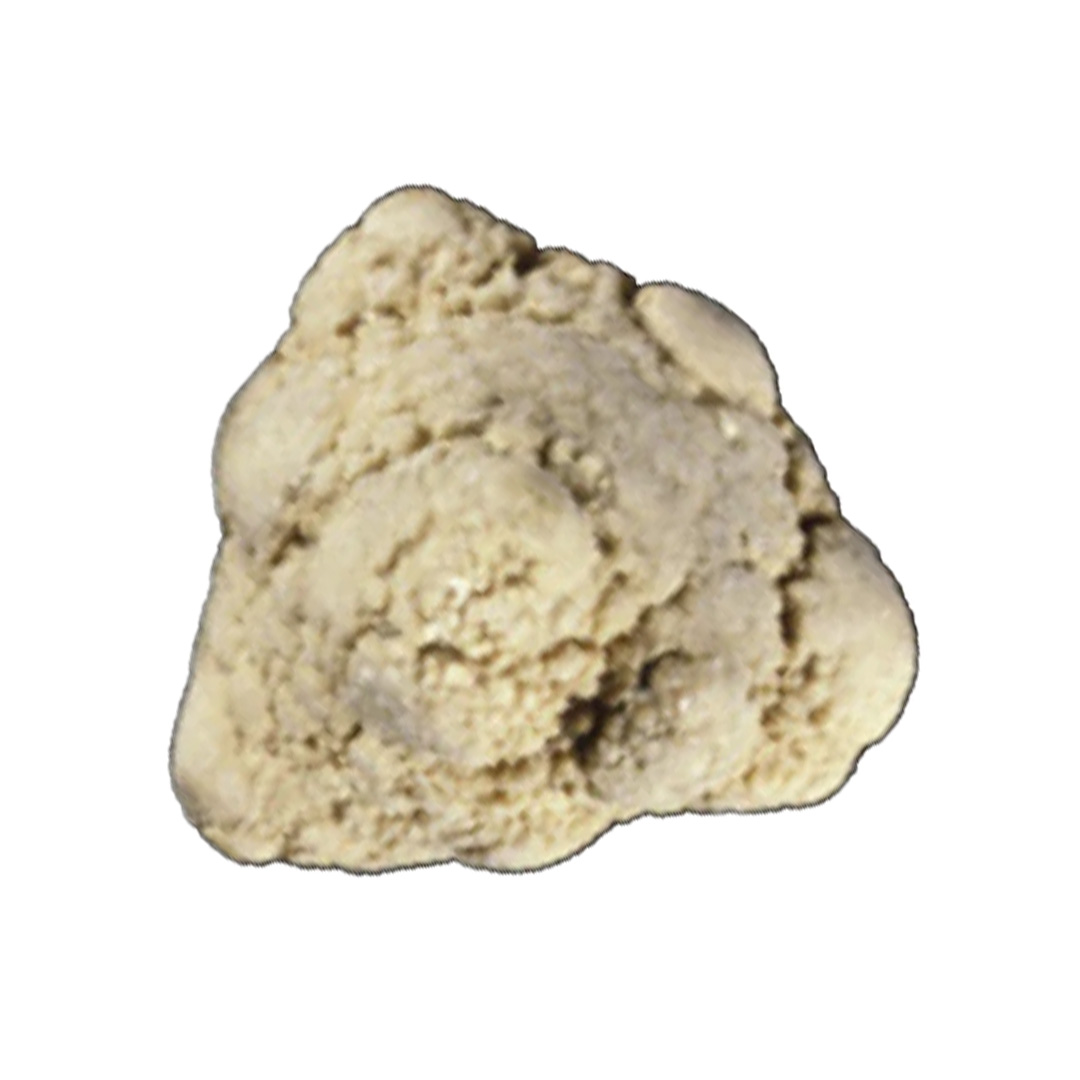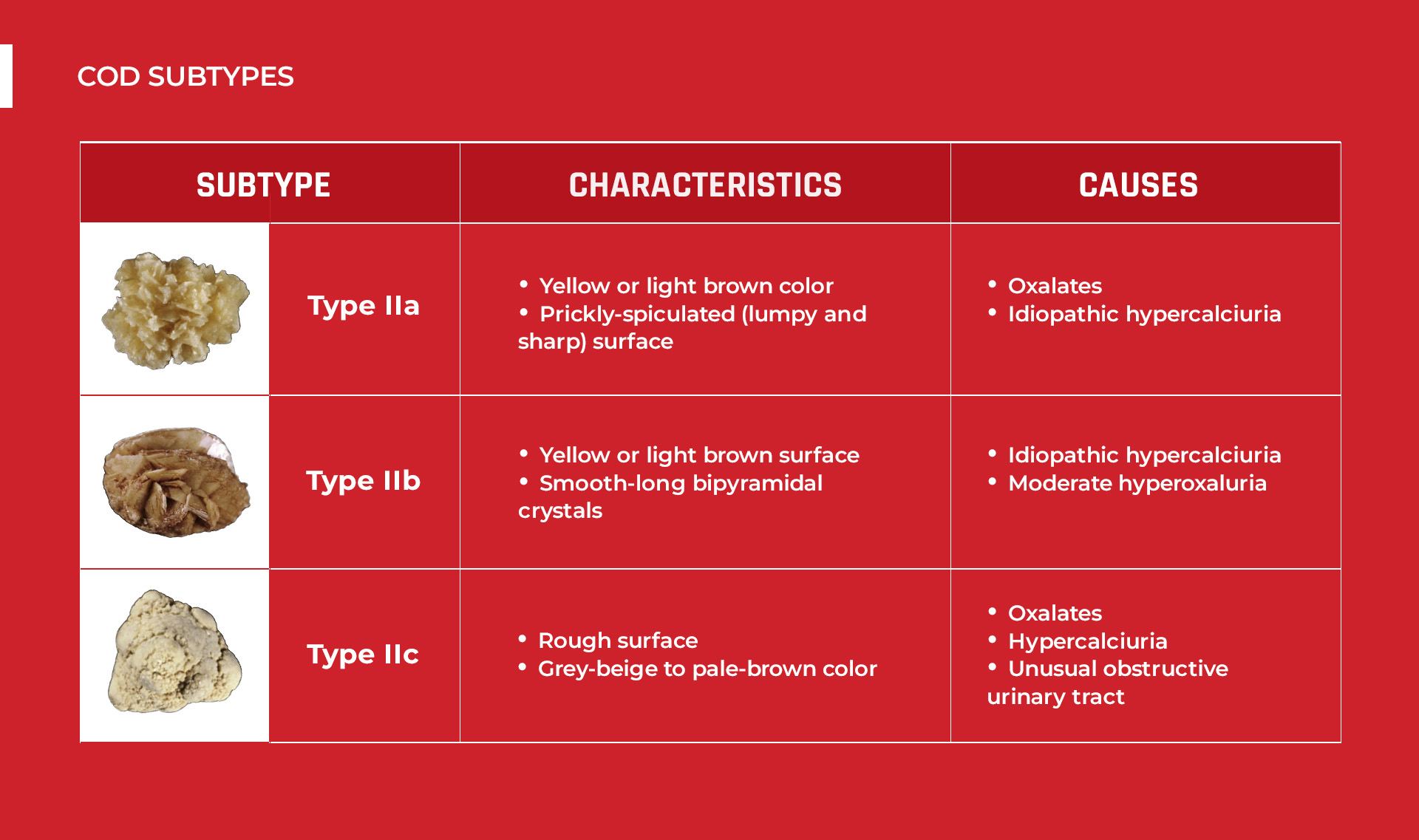Published: February 11, 2024 | 7 mins read
Calcium Oxalate Dihydrate Stones: Subtypes and Causes
Many people are not aware that kidney stones have five major types, each having their own unqiue sub-types under the line. One of these major types is Calcium Oxalate Stones (CaOx). These stones are the most prevalent, comprising about 80% of global kidney stone incidents.
CaOx stones are divided into two main categories. Our previous blog covered the first one, Calcium Oxalate Monohydrate (Type 1, also called COM stones). So, in this blog, we will discuss the other type, Calcium Oxalate Dihydrate (Type 2, also called COD stones).
CALCIUM OXALATE DIHYDRATE STONES
Compared to COM stones, COD stones are less dense. That’s because dihydrate crystals have two water molecules for every calcium-oxalate molecule. This extra water creates extra space between the molecules in the crystal, resulting in lower density. COM stones are different; they only have one water molecule per calcium-oxalate crystal. Since COD stones have a less tightly packed structure, they are softer and more fragile.
WHAT CAUSES COD STONES?
There are three main ingredients to watch out for if you want to combat this stone type:
1. A diet rich in oxalates
Oxalates are plant-defense chemicals found in nearly all plants. When you eat plant foods, oxalates accumulate in your body. The human body has no enzymes capable of metabolizing oxalates, so they are excreted in the stool or urine.
In the gut, a low level of oxalates may bind with calcium, reducing the amount of calcium your body can absorb. These unabsorbed nutrients are no longer bioavailable, so they will go straight to your stool.
Unbound oxalates, however, are absorbed in the gut into your bloodstream. These unbound oxalates will be excreted in the urine because they are not utilized by the body. As they stay in the kidneys, they bind with calcium, forming kidney stones.
For this reason, eating plant foods is not advisable for kidney stone-formers. Plant-based foods are the worst foods to eat as oxalates are responsible for around 80% of kidney stone burden globally. Daily oxalate intake must be lower than 80mg. That’s because urinary oxalate levels must not exceed 25 mg in 24-hour urine to prevent kidney stones.
You can check our Oxalate Contents of Foods PDF to have an idea of how much oxalates you are eating. Or, if you want a more personal approach to scrutinizing your diet, our Diet Coaching Program would be your perfect companion.
2. Hypercalciuria
COD stones are observed to form in a urine environment where calcium levels are particularly high (known as hypercalciuria), giving more outlets for oxalates to bind with them. This is when urine pH is around 5.5 (acidic).
Hypercalciuria means calcium levels exceed 250 mg in a 24-hour urine collection. There are two main reasons why this takes place:
- Vitamin D sensitivity. When the body abnormally reacts to vitamin D, calcium transport will increase, resulting in more calcium in the urine.
- Hyperparathyroidism. This happens when there’s too much release of parathyroid hormones (PTH). These hormones help regulate calcium levels in the blood. Thus, abnormally high PTH levels will disrupt the calcium balance in the body.
If you want to dig deeper into hypercalciuria’s role in kidney stone formation, read our Hypercalciuria blog.
3. Higher urine pH (above 6.5)
In a study involving 48 COD stones, researchers discovered that when urine pH is not lower than 6.5, COD stones will form even if calcium levels are normal. However, when there was hypercalciuria at pH 6.5, not only did COD crystals form, but also calcium phosphate crystals.
These results suggest that hypercalciuria and a high urine pH of around 6.5 significantly increase the risk of developing kidney stones. In fact, the data indicates that a COD stone fragment weighing only 5 mg could grow to 45 mg in just three months under these specific conditions.
IS CALCIUM INTAKE TO BLAME?
Dietary calcium is never to blame for calcium oxalate stones. That’s because calcium levels alone do not increase your stone risk. The real culprit for your kidney stones is oxalates. If you stop eating oxalate-rich foods, nothing will bind with calcium, so kidney stones won’t form.
Do not limit your calcium intake. The recommended daily allowance (RDA) for calcium is 1,200mg. It is best to get it from foods rather than supplements because it is more bioavailable in these forms. It is crucial to maintain this much intake because calcium is essential in many bodily functions.
THE THREE SUBTYPES OF COD STONES
Just like COM stones, COD stones also have subtypes. Listed below are the three known subtypes of COD stones:

Dihydrate Type IIa Stones
Type IIa kidney stones represent 69% of all Calcium Oxalate Dihydrate stones. This type has the following characteristics:
Exterior:
- Yellow or light brown color
- Prickly-spiculated (lumpy and sharp) surface due to clusters of bipyramidal crystals with sharp angles and edges
Interior:
- Shows a loose radial crystallization pattern
Typically, Type IIa is observed in individuals with idiopathic hypercalciuria. Idiopathic pertains to conditions with unknown origins. Most doctors would blame calcium intake for this; however, it is important to note that hypercalciuria is unrelated to dietary calcium intake. As explained in the previous section, urinary calcium increases due to high vitamin D and imbalanced PTH levels.

Dihydrate Type IIb Stones
This COD subtype represents about 30% of Type II stones. Type IIb kidney stones are characterized as follows:
Exterior:
- Yellow or light brown surface
- Smooth-long bipyramidal crystals (often resembling small desert roses)
Interior:
- Compact and poorly organized
These stones form under two conditions: idiopathic hypercalciuria and moderate hyperoxaluria. Again, a diet rich in plant matter is the primary reason oxalate levels increase (hyperoxaluria).

Dihydrate Type IIc Stones
Type IIc kidney stones are much less frequent and represent 0.7% of all COD stones. These stones have the following characteristics:
Exterior:
- Rough surface
- Gray-beige to pale-brown color
Interior:
- Diffuse-concentric internal structure
This type of kidney stone is observed in individuals with hypercalciuria and those with an unusual obstructive urinary tract. Also, they typically form in numbers as a result of stasis (bladder not emptying urine fully).
THE BOTTOM LINE
Whether you are forming Calcium Oxalate Monohydrate (COM) or Calcium Oxalate Dihydrate (COD) stones, the main culprit for your condition is oxalates. And that points to your diet rich in plant matter. Some people have tried several strategies to reduce their oxalate intake, like putting themselves into Paleo or Low-oxalate diets. However, these diets still failed many because oxalates are just too difficult to measure in your food. And so, even if you eat low-oxalate foods like lettuce or broccoli, you might still end up with nasty kidney stones if oxalates accumulate in your kidneys.
Thus, we suggest dropping these unfriendly foods and shifting towards animal-based or carnivore diets. Because meat and other animal products are absolutely ZERO OXALATES. These are the safest foods for kidney stone formers, not compromising the nutrient requirements of your body.
Check out our Coaching Program if you’re looking for guidance on how to stop kidney stones.
Lastly, taking a natural supplement, like CLEANSE, can help pass these less dense stones faster with less discomfort. Since COD stones are weak in density, the potent stone-breaking ingredients in CLEANSE can break-down the stone while inside your urinary tract, thus making it easier to pass.


Comments or questions?
Responses
WHAT TO READ NEXT
Publish Date: August 18, 2024
Staghorn Kidney Stones Are BIG Problems!
Publish Date: August 4, 2024
Brushite Stones: The Most Complex Kidney Stones
Publish Date: July 28, 2024
The Deadly Struvite Stones